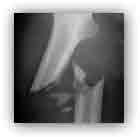|
New research has shed light on the high risk of fractures, falls, and osteoporosis among epilepsy patients using antiepileptic drugs (AEDs) with most patients unaware of the risks associated with taking the drugs.

The study led by the University of Melbourne and published in the prestigious Neurology journal, found that people taking antiepileptic drugs are up to four times more likely to suffer spine, collarbone and ankle fractures and are more likely to have been diagnosed with osteoporosis.
In addition, treatment affected balance with results showing almost double the falls rate in female patients taking the medication compared with non-users.
Chief Investigator, Prof John Wark from the University of Melbourne's Department of Medicine at the Royal Melbourne Hospital said this research revealed new information critical to understanding the higher risk for fractures and falls in epilepsy patients taking antiepileptic medication.
"We believe patients need to be offered better information to help them to avoid these risks and prevent injury," he said.
More than 70 percent of epilepsy patients who participated in the study were unaware of the increased risk of fractures, decreased bone mineral density and falls associated with taking antiepileptic medications.
"No published studies have explored epilepsy patients' awareness of the effects of AEDs on bone health, fracture risk and falls. This study indicates that awareness of these issues is poor, despite our study population attending specialist epilepsy clinics at a centre with a major interest in this area," said Prof
Wark.
"Epilepsy patients should be assessed regularly for their history of falls and fractures for appropriate management strategies to be offered."
The study compared 150 drug users with 506 non-users. All drug users were epilepsy outpatients at the Royal Melbourne Hospital, over 15 years old and had been taking AEDs for a minimum of three months.
Collaborators include La Trobe University, the National Ageing Research Institute, and the University of Malaya, Malaysia.
Also Christian Meier, Division of Endocrinology, Diabetes and Metabolism, University Hospital, CH-4031 Basel, Switzerland and Marius E. Kraenzlin, Division of Endocrinology, Diabetes and Metabolism, University Hospital, CH-4031 Basel, Switzerland analized this problem.
"In recent years there has been increasing evidence suggesting that epilepsy and its treatment can have adverse effects on bone mineralization and calcium metabolism. Many studies have shown a significant reduction in bone mineral density (BMD) and an increased fracture risk in patients treated with enzyme-inducing antiepileptics (phenobarbital, carbamazepine, phenytoin).
It is assumed that CYP450-inducing antiepileptic drugs (AEDs) upregulate the enzymes which are responsible for vitamin D metabolism, with the effect of converting 25(OH) vitamin D into inactive metabolites, resulting in reduced calcium absorption with consecutive secondary hyperparathyroidism.
Data on bone-specific effects of newer AEDs are limited; nevertheless, alterations of bone metabolism have been reported for oxcarbazepine, gabapentin and, in preclinical studies, for
levetiracetam.
Prophylactic administration of adequate amounts of calcium and vitamin D is recommended for all patients. For patients with long-term AED exposure, BMD measurement is recommended as part of osteoporosis investigation (especially for patients treated with enzyme-inducing AEDs and where there are major risk factors for fractures).
Drug therapy (bisphosphonates) is reserved for the treatment of patients who have a high fracture risk; there are no specific intervention studies available in patients with epilepsy.
For more information
University of Melbourne
Antiepileptics and bone health
http://tab.sagepub.com/content/3/5/235.abstract
(MDN)
|
![]()